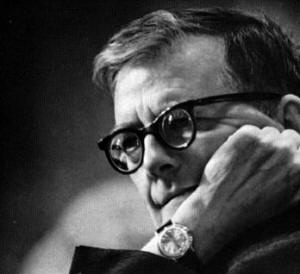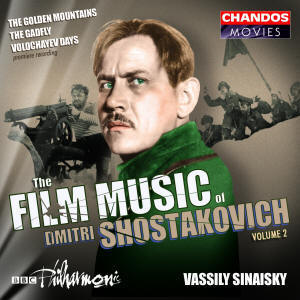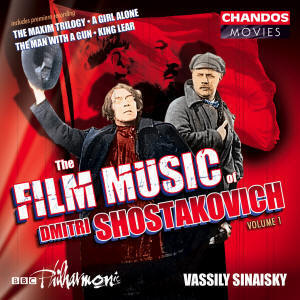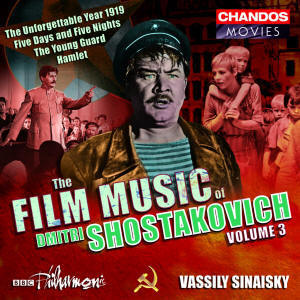|
You are reading the older HTML site Positive Feedback ISSUE november/december 2007
Film
Music of Dmitri Shostakovich,
Volumes 1, 2, and 3
Dmitri Shostakovich (1906-1975) was one of the greatest classical composers of the twentieth century and of all time. He wrote 147 works which included 15 symphonies, chamber works, vocal works, incidental music to plays, and 36 film scores. Much of Shostakovich's film music, however, has been lost or exists only in fragments. Of the surviving film music, much of the music for which scores exist have been put into concert suites. A few of these concert suites were assembled by Shostakovich shortly after the film score was written. However, most of the concert suites were assembled at a later date by his friend and admirer, Lev Atovmian. Despite the importance of Shostakovich as a composer, not much of Shostakovich's surviving film music is available on recordings. Thus, lovers of Shostakovich's music have usually heard little of his film music. Excerpts from the concert suites from "Hamlet" and "The Gadfly" are occasionally recorded, though rarely in their entirety. A few of Shostakovich's other film scores have also been recorded. Still, hearing much of Shostkovich's surviving film music has been difficult. Chandos Records, Ltd., the English purveyor of fine quality recordings, has tried to partially correct this problem with their "Movies" line of CDs. So far 23 CDs have been issued in this series. Each CD is devoted to the film music of one composer. All of the music on these CDs has been newly recorded with the BBC Philharmonic. Different conductors are used based upon their familiarity with the music. In a number of cases, the Chandos recording is the premiere recording of the music. Most of the composers selected for this series are associated with British films; e.g. Sir Malcolm Arnold, Sir Arnold Bax, Sir Arthur Bliss, Alan Rawsthorne, and Ralph Vaughn Williams (reviewed in PFO Issue 29). However, four of the 23 CDs are devoted to non-British composers—one CD for Nino Rota and three CDs for Shostakovich. The film music contained on these three Shostakovich CDs is shown below. The number to the left is the order in which the music was written; i.e. "A Girl Alone" was the second film score Shostakovich wrote; "King Lear" was his thirty-sixth and final film score. 2. Music from "A Girl Alone", 1931, Op.26 3. Suite from "The Golden Mountains" 1931, Op. 30 10. Incidental music from "Volochayev Days", 1937, Op. 48 Premiere recording 7., 9., 11. Fragments from the Maxim Trilogy ("The Youth of Maxim", 1935, Op.41, "The Return of Maxim" 1937, Op.45, and "The Vyborg Side", 1939, Op. 50) 14. Suite from "The Man with a Gun", 1938, Op. 53 Premiere recording 20. Suite from "The Young Guard", 1947, Op.75 26. The Assault on Red Hill from "The Unforgettable Year 1919", 1953, Op. 89 28. Suite from "The Gadfly", 1955, Op. 97 31. Suite from "Five Days and Five Nights", 1961, Op.111 33. Suite from "Hamlet", 1964, Op.116 36. Music from "King Lear", 1970, Op. 137 As you can see, Chandos has chosen music from each part of Shostakovich's career. Thus, you can hear the energy and simplicity of Shostakovich as a young man of 25 and also the sophistication of his final years. The music on the CDs is not arranged in chronological order, however. Each of the three CDs contains the following music (with playing time noted): Volume 1 Fragments from the Maxim Trilogy 27:15 Suite from "The Man with a Gun" 8:22 Music from "A Girl Alone" 21:02 Music from "King Lear" 18:18 Volume 2 Suite from "The Golden Mountains" 14:24 Suite from "The Gadfly" 42:20 Incidental music from "Volochayev Days" 9:16 Volume 3 Suite from "Hamlet" 28:47 The Assault on Red Hill from "The Unforgettable Year 1919" 7:29 Suite from "Five Days and Five Nights" 32:59 Suite from "The Young Guard" 10:05
Of the three CDs, Volume 2 is my favorite. "The Golden Mountains" is energetic and full of fun. As an example, the second section utilizes a Hawaiian slide guitar. Very whimsical. The entire suite is more symphonic in nature than his previous two film scores. "The Gadfly" is the most popular and the most often recorded of Shostakovich's film scores. This is great music and here it is presented in its entirety. "Volochayev Days" is a war movie dealing with the Soviet's fight against the Japanese in Siberia in 1921. The music is martial with lots of bugle calls, brass and snare drums. A short work, but exciting.
Volume 1 is my next favorite. The Maxim Trilogy is really a misnomer. This suite was assembled by Lev Atovmian using music from the first two Maxim films, but not from the third, "The Vyborg Side". It also contains two sections that are taken from "The Unforgettable Year 1919". Regardless of which films the music came from, this is a wonderful suite. The song for chorus which opens the suite is worth the price of the CD alone. The rest of the suite is equally as good. "The Man with a Gun" is very different. In 1936, Shostakovich was denounced as part of the ‘Great Terror'. From that time, until Stalin's death in 1953, Shostakovich lived in fear of being exiled to Siberia or executed. In order to stay alive Shostakovich changed his musical style. It became more populist, more in tune with the music of the masses (and the Communist Party line) and much more conservative. "The Man with a Gun" reflects this change. It does not really sound like Shostakovich. It sounds more like the music from a 1940s Hollywood swashbuckler. It is good music, though, just totally different. In the "A Girl Alone" the young Shostakovich is painting landscape portraits with music. His playful light-heartedness is very reminiscent of his "Age of Gold" ballet suite (Op.22) which was composed just a year before. Very nice music—wish it was more than 21 minutes long. "King Lear" is the opposite of "A Girl Alone". "King Lear" is a somber tragedy written close to the end of Shostakovich's life. This is a fully mature Shostakovich and the music reminds one of his last two symphonies. The suite recorded here only contains 8 of the 19 sections—less than half. It would have been nice to hear the whole suite. Perhaps Chandos thought listening to the entire suite would to be too depressing.
Volume 3 is a mixed bag. It contains most of "Hamlet", only omitting only one section of the eight. The music is excellent, which is why it has been recorded and is played in the concert halls. The Assault on Red Hill from "The Unforgettable Year 1919" is, in reality, the allegro movement of a piano concerto. However, with its flowing, romantic melodies it sounds more like Rachmaninoff, than Shostakovich. Very enjoyable. I wish it were longer than seven minutes. "Five Days and Five Nights" is a documentary film that deals with the Dresden Museum art collection that was hidden underground by the Nazis and liberated and taken back to Russia by the invading Soviet army. The collection was returned to East Germany in 1955. The film runs the gamut from somber, funereal music as the camera pans Dresden in ruins fifteen years after WWII to triumphant music for camera shots of the victorious Soviet Army. The music is of primary interest because of its musical quotes. Shostakovich fans will hear quotes from the String Quartet No. 8 which was written at the same time as the film music. One can also hear parts of the 11th and 12th symphonies which were composed immediately after the film music. Virtually every classical music lover will recognize the lengthy quote from Beethoven's Ode to Joy from his Ninth Symphony. Interesting music from a musicology view point. I don't know how it would hold up to repeated listening. "The Young Guard" is the weakest of the works on this CD. The orchestral finale of The Song of the Young Guardsman is stirring, but the other sections just did not hold my interest. Conclusion The music on these three CDs is well performed and is recorded and pressed to Chandos' high standards. The music on Volume 2 should appeal to any classical music lover and I highly recommend it. If you like Volume 2 and want more, then by all means buy Volume 1. Also highly recommended. Volume 3 is for Shostokovich aficionados only, though every classical music lover should at hear The Assault on Red Hill at least once. Chandos Records Ltd. www.chandos.net
|




